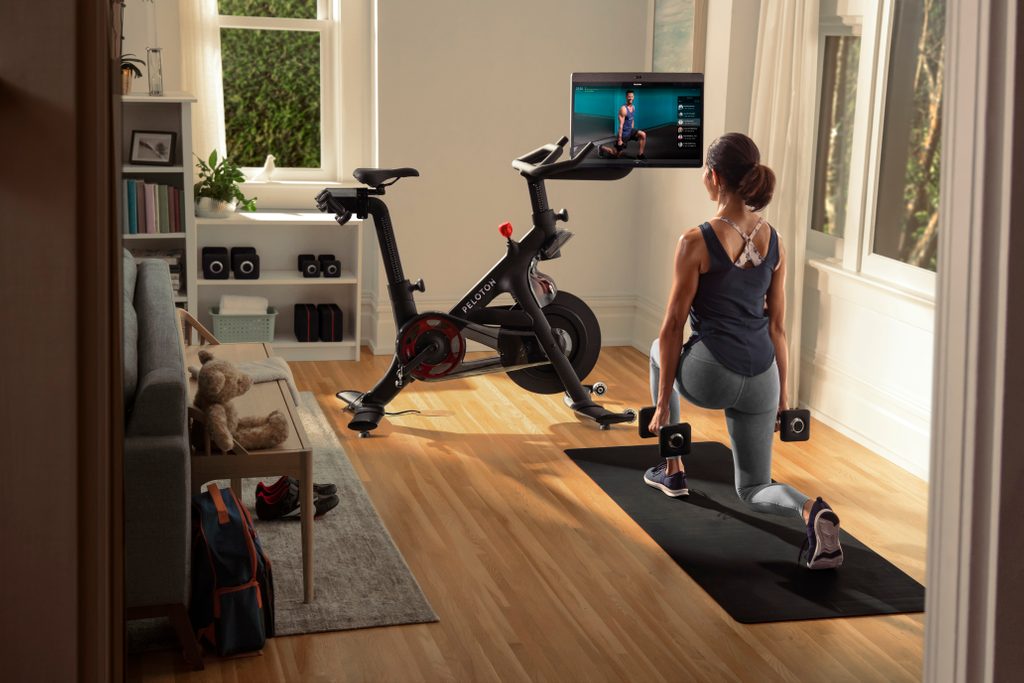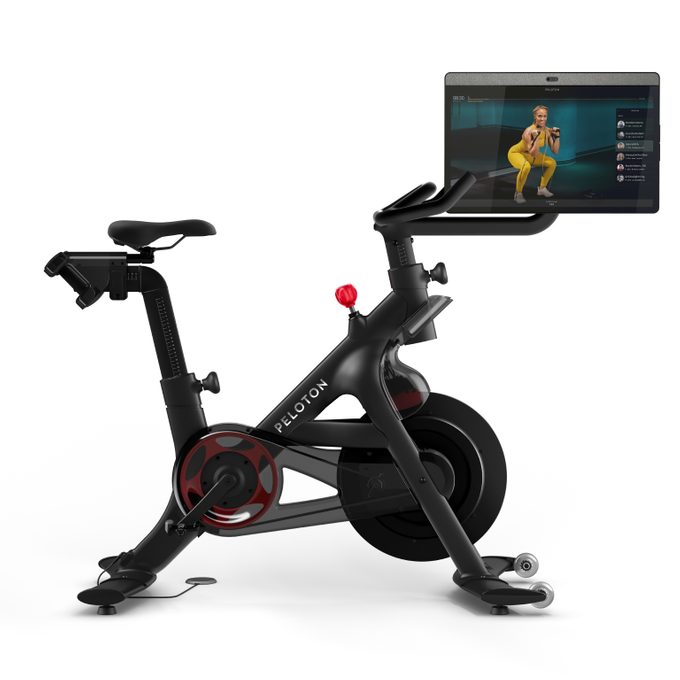Is The New Peloton Bike+ Worth the Price?

We put its fancy features to the test.
It’s been two years since Peloton first rolled into Canada with a sleek new way to sweat from our living rooms. Now, the New York–based home fitness brand is kicking up its offering with a souped-up spin bike aptly named Bike+.
The timing is right, with COVID-19 pushing us all to recalibrate our exercise routines. In the past year, Peloton’s global community more than doubled to 3.6 million, which is significant, considering its steep price tag. (It’s hard to believe that it was only last Christmas that Twitter dragged that commercial where a husband gifted his wife a Peloton bike.)
Bike+ was designed to make it easier to incorporate strength-training into your workouts. For example, its screen does a full swivel so you can easily follow along when lifting weights off the bike. “What we’ve heard from our community is how important non-cycling activities are,” says Jamie Herbert, the general manager of Peloton Interactive Canada.
That do-it-all idea appeals to my pre-pandemic self, whose mornings alternated between steamy spin classes and heart-pumping HIIT workouts. But lately, I’ve been struggling to find an at-home workout I can stick to. I borrowed a Bike+ to see if it could get me back on track and answer the big question: Is it worth the investment?
(Related: Need Some Fitness Inspo? Here Are 9 Amazing Canadian Women to Follow Now)
How much do Peloton’s Bike and Bike+ cost in Canada?
The new Peloton Bike+ rings in at a steep $3,295 (the company offers an interest-free financing option that breaks it into $85 payments over 39 months). The price of the original bike has dropped almost $500, to $2,495 (or, $64 payments over 39 months).
In addition to the machine itself, you’ll need the $49-per-month Peloton All-Access Membership to tune into its live and on-demand classes. (You only need one membership per household).
What do the original Peloton Bike and new Bike+ have in common?
At first glance, it’s hard to tell the Bike and Bike+ apart. Both have a similar frame design and take up the same amount of space in your home (you’ll need four feet by two feet). The ride feels almost identical too, with Peloton’s smooth, quiet flywheel and belt-drive transmission.
With the same app and interface on both machines, you can also count on the programming that Peloton is known for. And though there are some classes that combine spinning with floor-work sections where the Bike+’s rotating screen comes in especially handy (more on that below!), you can technically do any class on any bike.
(Related: Can’t Fit In a Full At-Home Workout? Do This)
What are the key differences between the Peloton Bike and Bike+?
When I first read about Bike+’s shiny new features, I thought they seemed minor and likely not worth the extra money. But after my first Bike+ ride, I had a whole new view—these thoughtful improvements really add up to a next-level workout:

1. The rotating screen
The Bike+’s monitor can pivot 180 degrees in either direction and also tilt up and down. It’s one of the main selling points of the Bike+, which Herbert told me was inspired by feedback from Peloton users as well as the popularity of the app’s floor-workout classes.
With the original bike, I’ve done strength and stretch classes standing nearby, peeking at the screen when I can and mostly following along to the instructor’s voice. It worked, but didn’t exactly motivate me to seek out these types of classes (or to stay focused when I did).
But on the Bike+, the newly launched Bike Bootcamp classes are my favourite. You start on the bike, hop off for a strength-training segment on the floor, then cycle again to wrap it all up. And being able to move the screen around during the class keeps my head in the game—that hundredth sit-up is hard enough without having to crane my neck to see a screen.
2. The auto-follow feature
Here’s another one I initially scoffed at: instead of manually adjusting the resistance knob every time the instructor gives a new cue, Bike+ can automatically change it for you. Turning a dial isn’t that hard, I had thought. But when I tested it out, I realized the main benefit isn’t about saving you the tiny effort of adjusting your resistance—it’s about removing the decision of whether or not to do so.
Almost every class, there’s a point where I’m dripping with sweat, my quads are on fire and the instructor asks, “Can you add two more to your resistance?” Before I even start to process the question, something inside of me has already yelled, “Pffft no!” TheBike+’s auto-follow feature allows the resistance to magically adjust before my inner saboteur can speak up. Now that I’ve started using auto-follow, I’m working out harder, and I’m completely hooked. (The one catch is that auto-follow only works for on-demand classes, not live ones.)
3. The Apple GymKit integration
This one only works if you’ve got an Apple Watch—something I’ve been leaning on more and more during the pandemic. (Turns out, when I’m working from home 24/7 and the world feels upside down, the simple mission of closing my activity rings really does help me stay grounded.)
To use GymKit, you just have to hold your wrist up to the top of the screen at the start of class to sync up your watch. So far, mine has paired quickly every time. After that, the watch transmits my heart rate onto the Peloton screen throughout the class, and the duration, distance, calories and more all get synced up with my watch—little snippets of data that work well to motivate me.
In addition to those standouts, the Peloton Bike+ offers a slew of other enhancements:
- An improved sound system, with two front-facing speakers added to the original bike’s pair of rear-facing ones
- A bigger display screen
- A better-quality camera for video-chatting with friends during class, along with a privacy cover if—like me—that’s not your thing
- Seat and handlebar knobs and levers that are easier to adjust (this one’s handy if you’re sharing the bike with, ahem, a partner who turns the knobs way too tight)
(Related: 10 Foods to Avoid Before a Workout)
So, is the Peloton Bike+ worth it?
Until now, I’ve always felt that the real Peloton draw is its programming rather than the machine itself (the new Beyoncé partnership seals the deal for me, with tons of new Bey-themed classes to choose from). The app is really well designed; the instructors are inspiring; the community is huge. Sure, I like the design of the original bike and its smooth, nearly silent ride, but the pragmatic part of my brain always chimes in that it’s not enough to justify dropping a couple thousand. For just a few hundred, I could buy a good-enough alternative and use it with the Peloton app on an iPad.
That’s still true, but the Bike+ has me reconsidering. The addition of auto-follow, full screen rotation and Apple GymKit make the Peloton Bike+ worth the investment, in my opinion. The sum is no joke, but those three feature are all ones that motivate me to exercise more frequently—and to work harder when I do. And at this stage of the pandemic—when my old routine of 7 a.m. spin classes is a distant memory, my work-life balance is completely off-kilter, and my living-room workouts are half-hearted at best—anything that helps me prioritize my physical and mental health is an investment I can justify.
Next: Why You Should Buy Cycling Shoes if You Use an Exercise Bike at Home




